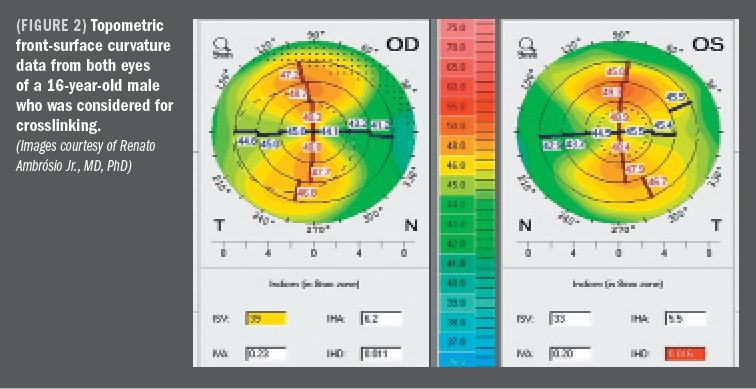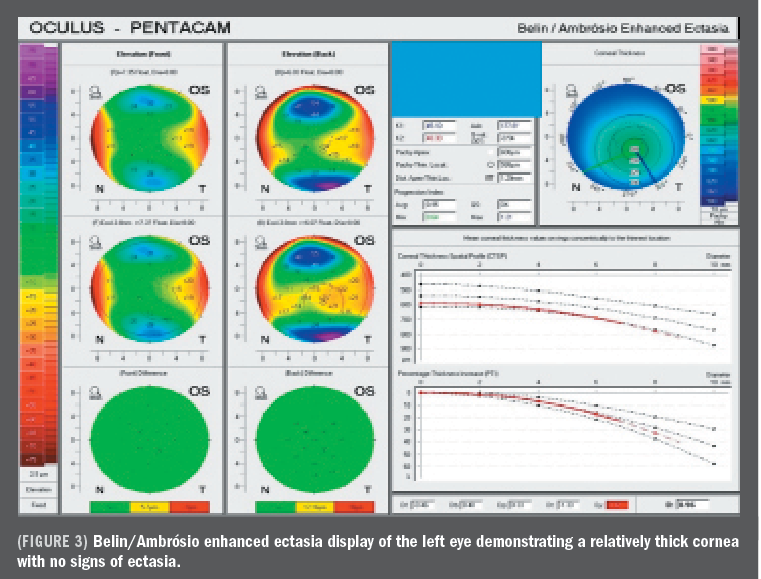Article
Corneal tomography or topography: When to make the clinical decision
Findings from anecdotal case reports are supported by clinical studies to highlight the relevance of advances in corneal imaging to help evaluating the cornea.
By Cheryl Guttman Krader; Reviewed by Renato Ambrósio Jr., MD, PhD
Corneal tomography represents a major advance for diagnosis, prognosis, and treatment planning, but there remains a need for classic imaging technologies, such as Placido topography, along with a comprehensive clinical evaluation, said Renato Ambrósio Jr., MD, PhD.
Scheimpflug corneal tomography is a three-dimensional imaging technique that characterizes the anterior/posterior corneal surfaces, along with corneal thickness distribution.
Dr. Ambrósio said that a classic question about tomography relates to whether it is a more sensitive modality than Placido disk-based topography to detect mild forms of keratoconus and screen for ectasia risk prior to refractive laser vision correction (LVC).
Findings from research conducted by Dr. Ambrósio and others involving cases with very asymmetric ectasia (VAE) along with lessons learned from many case reports of post-LVC ectasia indicate that the answer is unquestionably “yes”.1-13 Nevertheless, there is still room for improving its performance in this application.
“In the quest for enhanced ectasia diagnosis, we have to go beyond topography, which only provides two-dimensional information about the front surface of the cornea," said Dr. Ambrósio, professor of ophthalmology, Federal University of the State of Rio de Janeiro (UniRIO), Brazil.
“Corneal topography does augment sensitivity to detect keratoconus in many cases with normal biomicroscopy and normal corrected visual acuity and is also efficient for identifying clinical keratoconus,” he said. “But the occurrence of cases of post-LASIK ectasia in eyes without identifiable risk factors shows the need to better identify subclinical disease and characterize inherent ectasia susceptibility,”
While objective indices for the categorization of tomographic data have been developed, recognizing that ectasia risk is influenced by the biomechanical status of the cornea supports the use of biomechanical characterization.
The integrated Scheimpflug-based corneal tomography and biomechanical analysis provided with the Pentacam and Corvis systems (both Oculus) generates the Tomographic and Biomechanical Index (TBI), which was developed to enhance diagnostic sensitivity, he said.
The TBI was developed by Dr. Ambrósio and colleagues in a multicenter study including one randomly selected eye from subgroups of patients with normal (n = 480) or keratoconic corneas (n = 204) and using the random forest method with leave-one out cross-validation, an efficient artificial intelligence technique for classification.1 The study also included 94 eyes with normal topography from patients with VAE. The latter eyes were considered to have normal topography if they presented with KISA <60, IS-value <1.45, central K <47, and no positive finding on the topometric classification.
“The TBI was demonstrated to be more accurate for detecting ectasia than both the tomography-derived Belin/Ambrósio Deviation score and the biomechanical information alone, and external validation studies were performed in India, Germany, Iran, United States, and Brazil using data from several independent patient populations,” Dr. Ambrósio said.

Case reports
Published case reports further illustrate the value of including tomography and biomechanical assessments for the diagnostic evaluation of patients in clinical practice.
One such report described a case of unilateral ectasia identified in a patient who had been referred for treatment of keratoconus in his right eye.14 Unilaterality of the ectatic disease was confirmed by extensive diagnostic evaluation, including Placido disk-based corneal topography, Scheimpflug corneal tomography, ocular wavefront analysis, and corneal segmental tomography with epithelial thickness mapping by very high frequency digital ultrasound and spectral-domain OCT.
“The patient admitted he was rubbing the right eye,” Dr. Ambrósio said. “We know ectasia can occur in any eye, but as we established in the global consensus, although keratoconus can be asymmetric, it is always bilateral.”
Another report presented the case of a patient who developed post-LASIK ectasia despite being considered at low risk based on preoperative topographic evaluation.12 Findings from corneal tomographic and biomechanical measurements identified ectasia risk in the fellow unoperated eye (Figure1).

“The unoperated eye would be considered a good candidate for LASIK based on findings from standard screening methods, which included a normal front surface topography and central corneal thickness of 542 µm,” he said.
Similarly, tomography and biomechanical information identified subclinical keratoconus in eyes of identical twins, of which only one sibling had developed clinical keratoconus in one eye.15 One twin presented with VAE and subclinical (fruste) keratoconus in the fellow eye, and the sibling presented with bilateral fruste disease.
A case involving a 16-year-old male with progressive loss of distance-corrected visual acuity illustrated that while tomography can rule out keratoconus, additional anterior segment data was needed to establish the cause of the vision loss, which was a subluxed lens.13
Interestingly, the patient was being considered for corneal crosslinking based on loss of visual acuity and abnormalities seen on topography (Figure 2).

No evidence of ectasia was found on tomography (Figure 3), however, and the correct diagnosis was possible using the Scheimpflug images (Figure 4).
“Older technologies may be replaced, but not the case for Placido topography,” he said. “The data it provides for evaluation of the ocular surface and tear film is very relevant for clinical decisions. There is a need to be conscious about what we are trying to detect or measure.”

References
1. Ambrósio R, Jr., Lopes BT, Faria-Correia F, et al. Integration of Scheimpflug-based corneal tomography and biomechanical assessments for enhancing ectasia detection. J Refract Surg. 2017;33:434-43.
2. Ambrósio R, Jr., Ramos I, Lopes B, et al. Ectasia susceptibility before laser vision correction. J Cataract Refract Surg. 2015;41:1335-6.
3. Ambrósio R, Jr., Valbon BF, Faria-Correia F, Ramos I, Luz A. Scheimpflug imaging for laser refractive surgery. Curr Opin Ophthalmol. 2013;24:310-20.
4. Belin MW, Villavicencio OF, Ambrósio RR, Jr. Tomographic parameters for the detection of keratoconus: suggestions for screening and treatment parameters. Eye Contact Lens. 2014;40:326-30.
5. Lopes BT, Ramos IC, Dawson DG, Belin MW, AmbrósioR, Jr. Detection of ectatic corneal diseases based on pentacam. Z Med Phys. 2016;26:136-42.
6. Luz A, Lopes B, Hallahan KM, et al. Enhanced combined tomography and biomechanics data for distinguishing forme fruste keratoconus. J Refract Surg. 2016;32:479-94.
7. Muftuoglu O, Ayar O, Ozulken K, Ozyol E, Akinci A. Posterior corneal elevation and back difference corneal elevation in diagnosing forme fruste keratoconus in the fellow eyes of unilateral keratoconus patients. J Cataract Refract Surg. 2013;39:1348-57.
8. Patrao LF, Canedo AL, Azevedo JL, Correa R, Ambrósio R, Jr. Differentiation of mild keratoconus from corneal warpage according to topographic inferior steepening based on corneal tomography data. Arq Bras Oftalmol. 2016;79:264-7.
9. Ruiz Hidalgo I, Rodriguez P, Rozema JJ, et al. Evaluation of a machine-learning classifier for keratoconus detection based on Scheimpflug tomography. Cornea. 2016;35:827-32.
10. Saad A, Gatinel D. Topographic and tomographic properties of forme fruste keratoconus corneas. Invest Ophthalmol Vis Sci. 2010;51:5546-55.
11. Wolf A, Abdallat W, Kollias A, et al.. Mild topographic abnormalities that become more suspicious on Scheimpflug imaging. Eur J Ophthalmol. 2009;19:10-7.
12. Ambrósio R, Jr., Dawson DG, Salomao M, et al.. Corneal ectasia after LASIK despite low preoperative risk: tomographic and biomechanical findings in the unoperated, stable, fellow eye. J Refract Surg. 2010;26:906-11.
13. Valbon BdF, Santos RT, Ramos I, et al. A tomografia de córnea e segmento anterior na propedêutica do exame complementar na avaliação de ectasia. Revista Brasileira de Oftalmologia. 2013;72:54-8.
14. Ramos IC, Reinstein DZ, Archer TJ, et al. Unilateral ectasia characterized by advanced diagnostic tests. IJKECD. 2016;5:40-51.
15. Guerra G, de Oliveira VB, Ferreira I, et al. Subclinical keratoconus detection in identical twins. IJKECD. 2016;5:35-9.
Renato Ambrósio Jr., MD, PhD
e: dr.renatoambrosio@gmail.com
This article was adapted from Dr. Ambrósio's presentation during Cornea Subspecialty Day at the 2017 meeting of the American Academy of Ophthalmology. Dr. Ambrósio is a consultant for Oculus.
Newsletter
Don’t miss out—get Ophthalmology Times updates on the latest clinical advancements and expert interviews, straight to your inbox.




